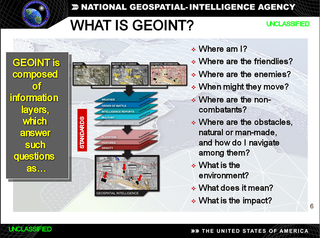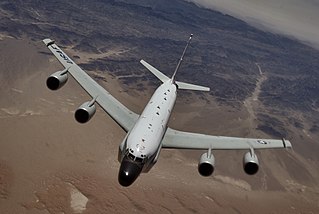Related Research Articles

Human intelligence is intelligence-gathering by means of human sources and interpersonal communication. It is distinct from more technical intelligence-gathering disciplines, such as signals intelligence (SIGINT), imagery intelligence (IMINT), and measurement and signature intelligence (MASINT). HUMINT can be conducted in a variety of ways, including via espionage, reconnaissance, interrogation, witness interviews, or torture. Although associated with military and intelligence agencies, HUMINT can also apply in various civilian sectors such as law enforcement.

Sensitive compartmented information (SCI) is a type of United States classified information concerning or derived from sensitive intelligence sources, methods, or analytical processes. All SCI must be handled within formal access control systems established by the Director of National Intelligence.
The intelligence cycle is an idealized model of how intelligence is processed in civilian and military intelligence agencies, and law enforcement organizations. It is a closed path consisting of repeating nodes, which will result in finished intelligence. The stages of the intelligence cycle include the issuance of requirements by decision makers, collection, processing, analysis, and publication of intelligence. The circuit is completed when decision makers provide feedback and revised requirements. The intelligence cycle is also called intelligence process by the U.S. Department of Defense (DoD) and the uniformed services.

In the United States, geospatial intelligence (GEOINT) is intelligence about the human activity on Earth derived from the exploitation and analysis of imagery, signals, or signatures with geospatial information. GEOINT describes, assesses, and visually depicts physical features and geographically referenced activities on the Earth. GEOINT, as defined in US Code, consists of imagery, imagery intelligence (IMINT) and geospatial information.
A stovepipe organization has a structure which largely or entirely restricts the flow of information within the organization to up-down through lines of control, inhibiting or preventing cross-organisational communication. Many traditional, large organizations have a stovepipe pattern. Intelligence organizations may deliberately adopt a stovepipe pattern so that a breach or compromise in one area cannot easily spread to others. A famous example of this is Bletchley Park where people working in one hut would not know what the people in any other hut did.

The Finnish Defence Intelligence Agency is the combined signals (SIGINT), geospatial (GEOINT) and imagery intelligence (IMINT) agency of the Finnish Defence Forces. Operational since 2014, its responsibility is to support the defence of Finland through information gathering and analysis as an intelligence agency, organic to the Intelligence Division of Defence Command.
Signals intelligence by alliances, nations and industries comprises signals intelligence (SIGINT) gathering activities by national and non-national entities; these entities are commonly responsible for communications security (COMSEC) as well.
Radiofrequency MASINT is one of the six major disciplines generally accepted to make up the field of Measurement and Signature Intelligence (MASINT), with due regard that the MASINT subdisciplines may overlap, and MASINT, in turn, is complementary to more traditional intelligence collection and analysis disciplines such as SIGINT and IMINT. MASINT encompasses intelligence gathering activities that bring together disparate elements that do not fit within the definitions of Signals Intelligence (SIGINT), Imagery Intelligence (IMINT), or Human Intelligence (HUMINT).
Materials MASINT is one of the six major disciplines generally accepted to make up the field of Measurement and Signature Intelligence (MASINT), with due regard that the MASINT subdisciplines may overlap, and MASINT, in turn, is complementary to more traditional intelligence collection and analysis disciplines such as SIGINT and IMINT. MASINT encompasses intelligence gathering activities that bring together disparate elements that do not fit within the definitions of Signals Intelligence (SIGINT), Imagery Intelligence (IMINT), or Human Intelligence (HUMINT).
Electro-optical MASINT is a subdiscipline of Measurement and Signature Intelligence, (MASINT) and refers to intelligence gathering activities which bring together disparate elements that do not fit within the definitions of Signals Intelligence (SIGINT), Imagery Intelligence (IMINT), or Human Intelligence (HUMINT).

Signals intelligence operational platforms are employed by nations to collect signals intelligence, which is intelligence-gathering by interception of signals, whether between people or between machines, or mixtures of the two. As sensitive information is often encrypted, signals intelligence often involves the use of cryptanalysis. However, traffic analysis—the study of who is signalling whom and in what quantity—can often produce valuable information, even when the messages themselves cannot be decrypted.
Intelligence collection management is the process of managing and organizing the collection of intelligence from various sources. The collection department of an intelligence organization may attempt basic validation of what it collects, but is not supposed to analyze its significance. There is debate in U.S. intelligence community on the difference between validation and analysis, where the National Security Agency may try to interpret information when such interpretation is the job of another agency.
Intelligence cycle management refers to the overall activity of guiding the intelligence cycle, which is a set of processes used to provide decision-useful information (intelligence) to leaders. The cycle consists of several processes, including planning and direction, collection, processing and exploitation, analysis and production, and dissemination and integration. The related field of counterintelligence is tasked with impeding the intelligence efforts of others. Intelligence organizations are not infallible but, when properly managed and tasked, can be among the most valuable tools of management and government.
National intelligence programs, and, by extension, the overall defenses of nations, are vulnerable to attack. It is the role of intelligence cycle security to protect the process embodied in the intelligence cycle, and that which it defends. A number of disciplines go into protecting the intelligence cycle. One of the challenges is there are a wide range of potential threats, so threat assessment, if complete, is a complex task. Governments try to protect three things:

Special reconnaissance (SR) is conducted by small units, such as a recon team, made up of highly trained military personnel, usually from special forces units and/or military intelligence organizations. Special reconnaissance teams operate behind enemy lines, avoiding direct combat and detection by the enemy. As a role, SR is distinct from commando operations, but both are often carried out by the same units. The SR role frequently includes covert direction of airstrikes and indirect fire, in areas deep behind enemy lines, placement of remotely monitored sensors, and preparations for other special forces. Like other special forces, SR units may also carry out direct action and unconventional warfare, including guerrilla operations.
Failure in the intelligence cycle or intelligence failure, is the outcome of the inadequacies within the intelligence cycle. The intelligence cycle itself consists of six steps that are constantly in motion: requirements, collection, processing and exploitation, analysis and production, dissemination and consumption, and feedback.
The target-centric approach to intelligence is a method of intelligence analysis that Robert M. Clark introduced in his book "Intelligence Analysis: A Target-Centric Approach" in 2003 to offer an alternative methodology to the traditional intelligence cycle. Its goal is to redefine the intelligence process in such a way that all of the parts of the intelligence cycle come together as a network. It is a collaborative process where collectors, analysts and customers are integral, and information does not always flow linearly.

Target analysis is an examination of potential targets to determine military importance, priority of attack, and weapons required to obtain a desired level of damage or casualties. The Central Intelligence Agency defines it as, "network analysis techniques and specialized analytical tools to identify and detail key figures and organizations who may pose a threat to US interests."

Counter-IED efforts are done primarily by military and law enforcement with the assistance of the diplomatic and financial communities. It involves a comprehensive approach of countering the threat networks that employ improvised explosive devices (IEDs), defeating the devices themselves, and training others. Counter-IED, or C-IED, is usually part of a broader counter-terrorism, counter-insurgency, or law enforcement effort. Because IEDs are a subset of a number of forms of asymmetric warfare used by insurgents and terrorists, C-IED activities are principally against adversaries and not only against IEDs. C-IED treats the IED as a systemic problem and aims to defeat the IED threat networks themselves.
References
- ↑ Garrett, Laurie. 2007. The Challenge of Global Health. Foreign Affairs 86 (1): 14–38
- 1 2 3 4 Susan, Lawrence. "Understanding China's Political System - Federation of American Scientists" (PDF). Understanding China’s Political System. Congressional Research Service. Retrieved 8 September 2023.
- ↑ "I. Overview and Summary". Ftp.fas.org. 2008-05-30. Retrieved 2013-10-22.
- ↑ Garrett, Laurie 2007, 'The Challenge of Global Health', Foreign Affairs, vol. 86, no. 1, p. 22
- 1 2 Hersh, Seymour M. "Annals of National Security: The Stovepipe". The New Yorker. Retrieved 2013-10-22.
- ↑ U.S. Government, The 9/11 Commission Report, pp. 400–428
- ↑ Mitchell, Gordon R. "Team B Intelligence Coups," Quarterly Journal of Speech, Vol. 92, No. 2, May 2006, pp. 144–173
- ↑ "Accountability Review Board for Benghazi to Examine the Facts and Circumstances Surrounding the Attacks of September 11–12, 2012" (PDF). U.S. Department of State . Retrieved 2013-10-22.
- ↑ Johnson, Christopher (17 October 2017). "Xi's Signature Governance Innovation: The Rise of Leading Small Groups". Center for Strategic and International Studies. CSIS. Retrieved 8 September 2023.